Aeonium urbicum: The Majestic Saucer Plant of the Canary Islands
Family Origin: Aeonium urbicum, commonly known as the Saucer Plant or Salad Bowl, belongs to the Crassulaceae family. This magnificent succulent is native to the Canary Islands, specifically endemic to Tenerife, the largest and most populous island in the archipelago.
Native Habitat: Aeonium urbicum thrives in the northern part of Tenerife, stretching from Macizo de Anaga to Punta de Teno. It can be found at elevations ranging from 160 to 3,200 feet (50 to 1,000 meters). In its natural habitat, this remarkable species adapts to various conditions and flourishes in rocky, well-drained soils.
Characteristics of Aeonium urbicum:
Impressive Rosette and Inflorescence: Aeonium urbicum showcases a single, unbranched stem that supports a large rosette of spoon-shaped leaves. Over time, the rosette expands and becomes flat and open, reaching a diameter of over 12 inches (32 cm). After several years, A. urbicum produces a truly remarkable inflorescence. This dome-shaped structure can grow up to 30 inches (75 cm) tall and 18 inches (45 cm) in diameter, captivating with hundreds of small, star-shaped flowers in shades of greenish-white or pinkish-white.
Monocarpic Nature and Flowering: While Aeonium urbicum presents an awe-inspiring floral display, it is important to note that the plant is monocarpic. After flowering, the individual rosette that bloomed will die. Nevertheless, the beauty and grandeur of the inflorescence make it a captivating sight in any landscape.
Cultivating Aeonium urbicum:
Sunlight: Aeonium urbicum thrives in bright sunlight, making it ideal for gardens or containers in sunny locations. Full sun exposure promotes healthy growth and vibrant leaf coloration.
Watering: To prevent root rot, Aeonium urbicum requires excellent drainage and infrequent watering. Select containers with drainage holes and utilize well-draining cactus and succulent soil mixed with mineral grit such as coarse sand, pumice, or perlite. Water deeply enough to allow excess water to flow out of the drainage hole, and then allow the soil to thoroughly dry before watering again. During the plant’s summer dormancy period, reduce watering frequency.
Soil: A well-draining soil is crucial for the success of Aeonium urbicum. A cactus mix or sandy loam mix provides the ideal growing medium to support the plant’s health and vigor.
Pest and Disease Management: Aeonium urbicum generally remains pest- and disease-free, making it a relatively low-maintenance plant. However, occasional infestations by mealybugs and scale insects can occur. Promptly address these issues by treating affected plants with insecticidal soap or neem oil.
Propagation:
Aeonium urbicum can be propagated through leaf cuttings or offsets.
- Leaf Cuttings: Take a healthy leaf from the plant and allow it to dry for a few days to form a callus. Plant the callused end of the leaf in a well-draining soil mix, and with time, roots will develop, giving rise to a new plant.
- Offsets: Aeonium urbicum produces offsets, small plantlets that grow alongside the main plant. Gently remove these offsets and plant them in a well-draining soil mix. They will root and establish themselves as independent plants.
With proper care, Aeonium urbicum will thrive and continue to grace your garden or container with its spectacular rosettes for many years to come.
Summary:
- Aeonium urbicum is a stunning succulent that can grow up to 12 inches tall and wide, creating a captivating presence in any setting.
- The fleshy leaves of Aeonium urbicum display a beautiful blue-green coloration and are arranged in an enchanting rosette formation.
- In the spring, A. urbicum produces charming yellow flowers, adding a delightful touch to its already impressive appearance.
- Native to the Canary Islands, Aeonium urbicum holds a special place in gardens and is a popular choice for houseplants, adorning spaces with its unique beauty and resilience.






